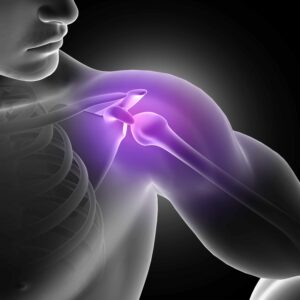Shoulder Dislocation is a common injury where the upper arm bone pops out of the shoulder socket, causing severe pain and restricted movement. This condition frequently affects athletes, active individuals, and those involved in high-risk activities, potentially leading to chronic instability if not properly managed. Understanding shoulder dislocation causes, symptoms, and treatment options is essential for restoring mobility and preventing long-term complications. From shoulder dislocation reduction techniques to specialized rehabilitation exercises, expert care can facilitate a return to an active life. Early diagnosis with a shoulder dislocation x-ray, combined with tailored treatment plans, is critical for optimal recovery and reducing recurrence risk.

What Is A Shoulder Dislocation?
A shoulder dislocation occurs when the humeral head (the ball-shaped top of the upper arm bone) is forcibly displaced from the glenoid cavity (the shallow socket of the scapula), disrupting the shoulder joint’s stability. As the most mobile joint in the body, the glenohumeral joint allows a wide range of motion—flexion, extension, abduction, adduction, and rotation—due to its shallow socket and reliance on soft tissue support, including ligaments, the labrum, and rotator cuff muscles [1, 2]. This mobility, however, makes it highly susceptible to dislocation, particularly under traumatic force [4, 5]. The injury can result in damage to the labrum, joint capsule, or rotator cuff, leading to immediate pain, swelling, and functional loss [3, 6].
The glenoid labrum, a ring of fibrocartilage that deepens the socket and enhances stability, is often torn during dislocation, especially in anterior cases where a Bankart lesion occurs [7, 9]. Similarly, the humeral head may sustain a Hill-Sachs lesion, a compression fracture from impacting the glenoid rim [8, 10]. Shoulder dislocations are categorized by direction—most commonly anterior (forward), but also posterior (backward) or inferior (downward)—each with unique mechanisms, clinical presentations, and treatment considerations [1, 3]. This injury is prevalent among young adults and athletes due to the joint’s exposure during dynamic activities, though it can affect anyone following significant trauma [2, 5]. Understanding the anatomical and biomechanical factors involved is crucial for developing effective treatment strategies to restore joint integrity and prevent future episodes [4, 6].
What Causes Shoulder Dislocations?
Shoulder dislocations are primarily triggered by traumatic events that exceed the joint’s normal range of motion, forcing the humeral head out of the glenoid cavity. Common causes include a fall on an outstretched arm, a direct blow to the shoulder during contact sports like football or rugby, or a sudden forceful twist, such as pulling the arm during a tackle or swing [2, 5, 7]. The classic mechanism for anterior dislocation involves the arm being abducted (raised) and externally rotated (turned outward), a position often seen in sports injuries or motor vehicle accidents [1, 6]. High-impact collisions, such as those in car crashes or falls from height, can also dislocate the shoulder by applying overwhelming force [3, 9].
Underlying joint laxity or a history of previous dislocations significantly increases susceptibility by weakening the stabilizing structures, including the inferior glenohumeral ligament and labrum [4, 8]. Repetitive overhead motions, common in sports like swimming, tennis, or baseball, can gradually stretch the joint capsule and predispose it to instability [9, 10]. Congenital factors, such as a naturally shallow glenoid, hypermobility syndromes like Ehlers-Danlos, or generalized ligamentous laxity, further elevate risk by reducing inherent joint stability [3, 7]. The initial dislocation often initiates a cycle of vulnerability, where damaged ligaments and labrum make subsequent dislocations more likely, emphasizing the need to address both acute injury and long-term structural integrity [5, 8].
Dislocated Shoulder Risk Factors
Several factors heighten the likelihood of experiencing a shoulder dislocation. Young age, particularly individuals aged 15-30, is a prominent risk factor due to active participation in sports and the ongoing development of joint structures, which may not yet be fully stabilized [2, 4]. Males are disproportionately affected compared to females, likely due to greater involvement in contact and high-impact sports [1, 5]. Athletes participating in contact sports (e.g., hockey, wrestling) or overhead sports (e.g., volleyball, swimming) face elevated risks due to repetitive joint stress and extreme ranges of motion [6, 9].
A history of previous shoulder injuries, such as prior dislocations, labral tears, or rotator cuff damage, markedly increases the chance of recurrence, as these events compromise the joint’s stabilizing mechanisms [3, 7]. Congenital or developmental conditions, including glenoid dysplasia, Ehlers-Danlos syndrome, or Marfan syndrome, contribute by enhancing joint laxity or altering bony anatomy [8, 10]. Occupational hazards, such as manual labor involving heavy lifting, awkward arm positions, or frequent falls, also play a role [6]. Additionally, poor muscle strength or coordination around the shoulder—often due to inadequate training or previous injury—exacerbates vulnerability, making targeted strengthening and proprioceptive exercises a critical preventive strategy [4, 10].
What Are Dislocated Shoulder Symptoms?
Dislocated shoulder symptoms typically manifest suddenly, with intense pain in the shoulder region being the most immediate and prominent complaint following a traumatic event [2, 3]. Patients often describe the pain as sharp, burning, or throbbing, which may worsen with any attempt to move the arm [5, 7]. A visible deformity is common, with the shoulder appearing flattened or squared off due to the humeral head’s displacement, and the acromion process may appear more prominent [1, 9]. Limited range of motion is a hallmark symptom, with difficulty lifting the arm, rotating it inward or outward, or performing overhead tasks [6, 10].
Swelling, bruising, and muscle spasms around the joint typically develop within hours, reflecting soft tissue trauma and inflammation [4, 8]. Numbness, tingling, or weakness in the arm or hand may indicate nerve compression, such as axillary nerve injury, a serious symptom requiring urgent medical attention [3, 7]. A sensation of instability, where the shoulder feels like it might “give way” or pop out again, is particularly common in recurrent cases [5, 9]. Pain may radiate to the neck, upper back, or chest, potentially mimicking conditions like angina or cervical radiculopathy, necessitating a thorough differential diagnosis [2, 10]. These symptoms highlight the importance of prompt evaluation to mitigate complications.
Types Of Shoulder Dislocation
Anterior Shoulder Dislocation
Anterior shoulder dislocation, comprising 95-97% of cases, occurs when the humeral head moves forward out of the glenoid cavity [1, 2]. This typically results from a fall on an outstretched arm with the shoulder abducted and externally rotated, a common scenario in sports or accidents [6, 7]. It frequently causes a Bankart lesion (anterior labral tear) and a Hill-Sachs lesion (posterior humeral head indentation), both of which increase the likelihood of recurrence [3, 9]. Symptoms include anterior prominence, severe pain, and inability to move the arm, with treatment focusing on prompt reduction and subsequent stabilization to prevent chronic instability [5, 10].
Posterior Shoulder Dislocation
Posterior shoulder dislocation, accounting for 2-4% of cases, involves the humeral head shifting backward into the posterior capsule [4, 8]. This often occurs due to axial loading on an adducted and internally rotated arm, such as during an epileptic seizure, electric shock, or a fall on the front of the shoulder [7, 9]. It may be missed on initial X-rays due to its subtle presentation, leading to delayed diagnosis and treatment [3, 6]. Associated injuries include reverse Hill-Sachs lesions, and management requires careful reduction techniques to avoid exacerbating damage to the joint or surrounding structures [1, 10].
What Are The Complications Of A Dislocated Shoulder?
Nerve And Blood Vessel Damage
Shoulder dislocation can injure the axillary nerve, leading to numbness or weakness in the deltoid muscle, or the brachial plexus, causing broader arm dysfunction [2, 4]. Axillary artery damage, though rare, poses a life-threatening risk due to potential bleeding or thrombosis, requiring immediate surgical intervention [5, 7]. These neurovascular injuries demand rapid assessment and management to restore function and prevent permanent damage [1, 9]. Symptoms like coldness, pallor, or loss of pulse in the arm are red flags [3, 8].
Chronic Instability And Repeated Dislocations
Chronic instability results from stretched or torn ligaments, labral injuries, or capsular laxity, leading to repeated dislocations [3, 6]. This can progress to shoulder osteoarthritis over time as the joint surfaces wear down from recurrent trauma [8, 10]. Repeated episodes further weaken the joint, increasing the need for surgical stabilization in severe or recurrent cases [4, 7]. Psychological impacts, such as fear of reinjury, may also develop, affecting quality of life and athletic performance [5, 9].
How Are Dislocated Shoulders Diagnosed?
Diagnosis starts with a detailed patient history, exploring the injury mechanism, pain onset, and any associated symptoms like numbness [1, 5]. Physical examination assesses for deformity, swelling, and range of motion limitations, using tests like the apprehension test (for anterior instability) or sulcus sign (for laxity) [3, 7]. Neurovascular status is checked to rule out nerve or vessel damage, comparing the injured shoulder with the unaffected side [6, 9]. This systematic approach ensures accurate differentiation from fractures, rotator cuff tears, or referred pain conditions [2, 10].
What Tests Will Be Done To Diagnose A Dislocated Shoulder?
Shoulder dislocation x-ray is the cornerstone of diagnosis, employing anteroposterior (AP) and axillary lateral views to confirm humeral head displacement and identify associated fractures [1, 2]. Additional projections, such as the scapular Y-view or West Point view, help detect Hill-Sachs or Bankart lesions [5, 7]. MRI provides detailed imaging of soft tissue damage, including labral tears, rotator cuff injuries, or joint capsule disruption, guiding treatment decisions [3, 8]. CT scans offer precise bony detail, useful for complex cases or surgical planning [4, 9]. Neurovascular studies, like Doppler ultrasound, may assess blood flow if vascular injury is suspected [6, 10].
How Are Dislocated Shoulders Treated?
Treatment focuses on relieving pain, restoring joint alignment, and preventing recurrence, with approaches varying by injury severity and patient needs [1, 3].
Non-Surgical Treatment Options
Non-surgical treatment begins with shoulder dislocation reduction, a procedure to manually reposition the humeral head, typically performed under sedation or anesthesia to minimize pain and muscle spasm [2, 5]. Common techniques include the Stimson method (gravity-assisted) or traction-countertraction [6, 10]. Post-reduction, immobilization in a sling or shoulder immobilizer for 1-3 weeks allows soft tissue healing, with the duration adjusted based on age and activity level [4, 7]. Pain management with NSAIDs, ice application, and rest supports recovery, suitable for first-time dislocations without significant structural damage [1, 3].
Rehabilitation And Physical Therapy Tips
Rehabilitation is crucial for restoring function and preventing recurrence. Initial shoulder dislocation exercises include gentle pendulum swings and isometric contractions to maintain range of motion without stressing the joint [9, 10]. As healing progresses, strengthening exercises targeting the rotator cuff (e.g., external rotation with resistance bands) and scapular stabilizers (e.g., wall push-ups) are introduced [3, 7]. Stretching routines, such as cross-body stretches or sleeper stretches, enhance flexibility, while proprioceptive training improves joint awareness [1, 5]. Therapy typically spans 6-12 weeks, with gradual return to sports under supervision [4, 8].
Shoulder Dislocation Treatment In Turkey
Turkey has become a leading destination for shoulder dislocation treatment, offering advanced orthopedic care through specialized clinics in cities like Samsun and Antalya. Facilities provide expert shoulder dislocation reduction using modern techniques, supported by state-of-the-art imaging like MRI and CT [1, 3]. Non-surgical options, including customized physical therapy programs with shoulder dislocation exercises, are widely available, emphasizing conservative management for initial injuries [5, 10]. For recurrent cases, surgical interventions like Bankart repair or capsulorrhaphy are performed by experienced surgeons, often at lower costs than in Western countries [2, 7]. Comprehensive packages, including pre- and post-operative care, attract medical tourists seeking high-quality treatment [4, 9].
What Is The Recovery Time For A Dislocated Shoulder?
Shoulder dislocation recovery time depends on treatment type and individual factors. Non-surgical cases, with proper immobilization and physical therapy, may see symptom improvement in 6-12 weeks, with full recovery taking 2-3 months [3, 9]. Post-reduction, immobilization lasts 1-3 weeks, followed by a graduated rehab program, allowing return to light activities in 6-8 weeks and full function in 3 months [1, 5]. Surgical cases, such as treatment for recurrent shoulder dislocation with procedures like Bankart repair, require 3-6 months for recovery, with athletes needing 6-12 months to resume competitive sports [2, 7]. Adherence to rehabilitation and avoiding premature stress are critical for optimal outcomes [4, 10].
Can I Prevent A Dislocated Shoulder?
Preventing shoulder dislocation involves strengthening the joint’s supporting muscles with targeted shoulder dislocation exercises, such as rotator cuff strengthening (e.g., side-lying external rotation) and scapular stabilization (e.g., prone Y-raises) [9, 10]. Avoiding risky movements, like sudden overhead reaches or tackles without proper form, reduces injury risk [1, 4]. Using protective gear, such as shoulder pads in contact sports, and maintaining flexibility with regular stretching can enhance stability [3, 7]. For individuals with a history of dislocation, surgical options like labral repair may prevent recurrence [5, 8]. Education on proper biomechanics and gradual conditioning is essential for long-term prevention [2, 6].
References
- Robinson CM, et al. Acute shoulder dislocations. J Bone Joint Surg Am. 2006;88(8):1890-1901. https://pubmed.ncbi.nlm.nih.gov/16882905/
- Zacchilli MA, et al. Epidemiology of shoulder dislocations presenting to emergency departments in the United States. J Bone Joint Surg Am. 2010;92(3):542-549. https://pubmed.ncbi.nlm.nih.gov/20194311/
- Hovelius L, et al. Primary anterior dislocation of the shoulder in young patients: a ten-year prospective study. J Bone Joint Surg Am. 1996;78(11):1677-1684. https://pubmed.ncbi.nlm.nih.gov/8934475/
- Itoi E, et al. Shoulder instability: current concepts review. J Orthop Sci. 2013;18(5):674-685. https://pubmed.ncbi.nlm.nih.gov/23832192/
- Rowe CR, et al. The Bankart procedure: a long-term end-result study. J Bone Joint Surg Am. 1978;60(1):1-16. https://pubmed.ncbi.nlm.nih.gov/624747/
- Kuhn JE, et al. A clinical method for identifying posterior instability. Am J Sports Med. 1999;27(5):733-738. https://pubmed.ncbi.nlm.nih.gov/10569365/
- Bankart ASB. The pathology and treatment of recurrent dislocation of the shoulder-joint. Br J Surg. 1938;26(101):23-29. https://pubmed.ncbi.nlm.nih.gov/20475192/
- Arciero RA, et al. Arthroscopic Bankart repair vs non-operative treatment for acute, initial anterior shoulder dislocations. Am J Sports Med. 1994;22(5):589-594. https://pubmed.ncbi.nlm.nih.gov/7810781/
- Wilk KE, et al. Rehabilitation of the overhead athlete’s shoulder. J Orthop Sports Phys Ther. 1997;27(5):333-346. https://pubmed.ncbi.nlm.nih.gov/9127727/
Provencher MT, et al. Management of traumatic anterior shoulder instability in the athlete. Curr Sports Med Rep. 2008;7(5):299-304. https://pubmed.ncbi.nlm.nih.gov/18815932/



